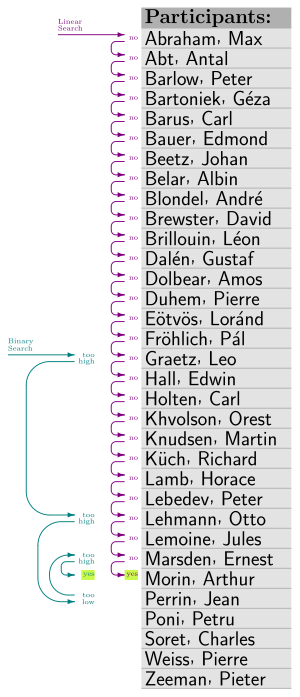Analysis of algorithms facts for kids

In computer science, the analysis of algorithms is about figuring out how much "work" a computer program, called an algorithm, needs to do. This "work" can be how much time it takes to run or how much computer memory it uses.
Usually, we try to find a mathematical rule that connects the size of the information an algorithm gets (its input) to the number of steps it takes. This is called its time complexity. Or, we look at how much storage space it uses, which is its space complexity.
An algorithm is considered efficient if it doesn't need much time or memory, or if its needs don't grow too quickly as the input gets bigger. Sometimes, different inputs of the same size can make an algorithm behave differently. So, we might look at the best, worst, or average ways it performs. When we don't say otherwise, we usually talk about the "worst case" performance. This means we look at the input that makes the algorithm take the longest or use the most memory.
The idea of "analysis of algorithms" was first used by Donald Knuth. It's a key part of a bigger field called computational complexity theory. This field tries to guess how many resources any algorithm will need to solve a certain problem. These guesses help us find better and more efficient algorithms.
When we analyze algorithms in theory, we often look at their performance for very, very large inputs. This is called "asymptotic analysis." We use special notations like Big O notation (written as O) to describe this. For example, a binary search algorithm is said to run in "logarithmic time" or O(log n). This means the number of steps it takes grows slowly, like the logarithm of the input size n.
We use these big-picture estimates because different ways of writing the same algorithm might have slightly different speeds. However, any two good versions of an algorithm will usually only differ by a constant amount of speed.
Sometimes, we can measure the exact efficiency, not just the big-picture estimate. But this often requires making certain assumptions about how the algorithm is set up. For example, if a sorted list has n items and we know each item can be checked in one unit of time, then a binary search will take at most log₂(n) + 1 time units.
How We Measure "Work"
When we talk about how efficient an algorithm is, we need to decide what counts as one "step." For our measurements to be useful, each step should take about the same amount of time. We have to be careful here. For instance, some analyses count adding two numbers as one step. But if the numbers are extremely large, adding them might take more time.
There are two main ways to measure the "cost" of operations:
- Uniform Cost Model: This model says that every basic computer operation, like adding two numbers, costs the same amount of time, no matter how big the numbers are.
- Logarithmic Cost Model: This model says that the cost of an operation depends on how many "bits" (the smallest pieces of computer information) are involved in the numbers. So, adding very large numbers would cost more.
The logarithmic cost model is more complicated, so we only use it when it's really needed. This happens when we're working with algorithms that handle numbers of any size, like those used in cryptography (making and breaking codes).
It's important to remember that the "lowest possible cost" for solving a problem is often based on a simpler computer model. This means that in real life, we might find algorithms that are even faster than what we first thought possible!
Why Algorithm Analysis Matters
Analyzing algorithms is very important in the real world. If a computer program uses an inefficient algorithm by mistake, it can really slow down a system.
- In apps where time is critical, like for weather forecasts or stock trading, an algorithm that takes too long can make its results useless.
- An inefficient algorithm might also need a huge amount of computer power or memory to run. This can make it too expensive or simply impossible to use in practice.
So, understanding how algorithms perform helps us build faster, more reliable, and more affordable computer systems.
Small Details, Big Impact
When we analyze algorithms, we usually focus on how they perform with very large amounts of data. But for practical uses, especially with smaller amounts of data, the "constant factors" can be important. This means the exact number of steps, not just the general growth rate.
For example, a simple algorithm might be slower for huge amounts of data but actually faster for small amounts. This is because the more complex, "efficient" algorithm might have more setup steps that take time.
This idea is used in "hybrid algorithms." These algorithms combine two different approaches. For instance, Timsort uses a fast algorithm called merge sort for most of the data. But for very small pieces of data, it switches to a simpler algorithm called insertion sort. Even though insertion sort is "less efficient" for large data, it's actually faster for tiny bits of data because it has less overhead.
See also
 In Spanish: Análisis de algoritmos para niños
In Spanish: Análisis de algoritmos para niños


